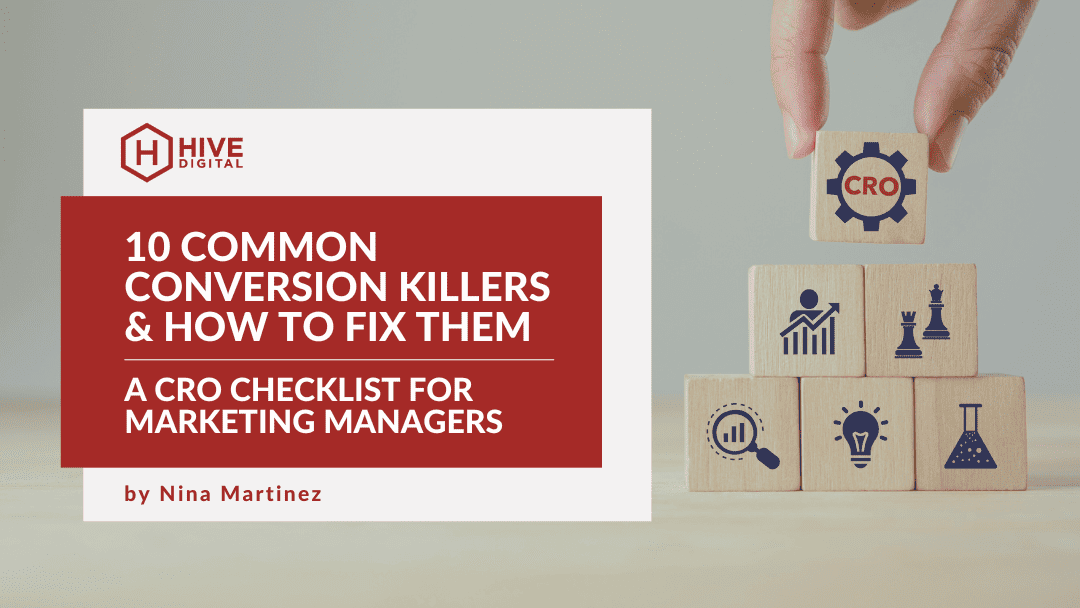Achieving high conversion rates is important to business success, making conversion rate optimization (CRO) an essential element of any marketing strategy. Most websites, however, have a number of challenges that can interfere with their conversion performance, resulting in lost opportunities and diminished revenue. To assist marketing managers in optimizing their conversion rates, our team has compiled this checklist of 10 common conversion killers and actionable tips on how to address them effectively:
1. Poor Website Design
Your website is often the first point of contact for potential customers–and first impressions are important. If your web pages appear cluttered, confusing, or dated, visitors are likely to bounce from your pages before even considering your offer.
Tips: Invest in a clean, intuitive design that easily and directly guides users through conversion points. Consider leveraging heatmapping and session-recording tools, like Microsoft Clarity or UX-specific solutions, to better understand user behavior and better inform future and iterative design decisions.
2. Lack of Clear Call-to-Actions (CTAs)
Your CTAs should be prominent, compelling, and clearly communicate the desired action. Weak or generic CTAs may fail to prompt user action; whereas, usage of persuasive CTAs that provide clarity typically have stronger engagement.
Tips: Avoid vague phrases like “Click Here” and instead use actionable phrases that convey value, with some examples being “Get Started Today” or “Claim Your Free Trial.” Also consider testing usage of contrasting colors and strategic placement to better capture user attention.
3. Slow Page Load Times
Today’s web users expect instant gratification–and if your website takes too long to load, visitors will abandon or “bounce” from your pages to seek alternatives. With long load times being a common contributor to high bounce rates, abandoned carts, and the like, it becomes evermore important to streamline web pages and address technical issues that can impact a user’s experience and, ultimately, their decision to convert.
Tips: Optimize your site’s performance by compressing image sizes, minifying code, leveraging browser caching, and investing in reliable hosting to improve page load speed. These steps can often be addressed by a seasoned web development and/or SEO team.
4. Complex Checkout Process
A lengthy or complicated checkout process can deter potential customers from completing their purchase by creating unnecessary points of friction and anxiety.
Tips: Streamline the process by minimizing form fields, enabling autofill features on form fields, offering guest checkout options, and providing clear progress indicators.
5. Lack of Social Proof
Without social proof, website visitors may question the credibility and reliability of your brand, negatively impacting conversion rates.
Tips: Testimonials, reviews, ratings, case studies, and user-generated content can serve as powerful social proof that can build trust with prospective consumers. Incorporate these elements strategically throughout your website to reassure visitors that others have had positive experiences with your products or services, and that they are invited to join this growing community of consumers as well.
6. Ineffective Targeting
Sending generic marketing messages to a broad audience is a recipe for low conversion rates, as it can limit traffic to your pages in the first place–by not truly resonating with users and limiting click-through-rate (CTR)–or can contribute to scenarios in which those users who do click through to the page feel the content falls short of their expectations.
Tips: Take the time to segment your audience based on demographics, behavior, preferences, and acquisition channel; then tailor your messaging and offers accordingly to drive users to a page that matches the promise of the messaging.
7. Ignoring Mobile Users
With an increasing number of people accessing the internet via mobile devices, optimizing for mobile is no longer optional—it’s essential. Evolving with the times is important, as not optimizing for mobile devices risks the loss of potential customers.
Tips: Ensure that your website is responsive and mobile-friendly, with fast loading times and intuitive navigation for a seamless user experience across all devices.
8. Poorly Optimized Landing Pages
Landing pages are often the gateway to conversions, so it’s crucial to optimize them for maximum impact. Not only are optimizations for usability and aesthetics important, but so too are content optimizations that demonstrate a brand’s understanding of their users’ motivations and values.
Tips: Keep messaging consistent with ad campaigns, minimize distractions, and continue to A/B test elements like headlines, copy, and imagery to identify what resonates best with your audience. Also be sure to clearly communicate the benefits and value propositions from your users’ perspectives.
9. Lack of Trust Signals
Trust is the foundation of any successful customer relationship, and visitors may hesitate to make a purchase if they don’t trust the website or brand.
Tips: Be sure to include trust signals such as security badges, SSL certificates, guarantees, and links to your privacy policy to reassure visitors that their information is safe and their satisfaction is guaranteed.
10. Failure to Test and Iterate
Conversion optimization is an ongoing process that requires constant monitoring and refinement. Without ongoing testing and optimization, marketing efforts may stale and lead to missed opportunities.
Tips: Consider implementing a regular, systematic approach to CRO testing (be it A/B testing and/or multivariate testing); track and analyze key performance metrics to identify areas for improvement; and continue iterating to fine-tune your approach and drive business growth.
Key Takeaways
By addressing these common conversion killers, marketing managers can enhance the effectiveness of their conversion rate optimization (CRO) efforts and encourage greater successes from their digital marketing campaigns. It’s important to remember, though, that CRO is an ongoing process; so, it’s important to be proactive in identifying and addressing barriers that would otherwise limit performance.
If you’re interested in learning more about these tactics and/or how they can be applied to your digital strategy, feel free to connect with our team for your free consultation.

